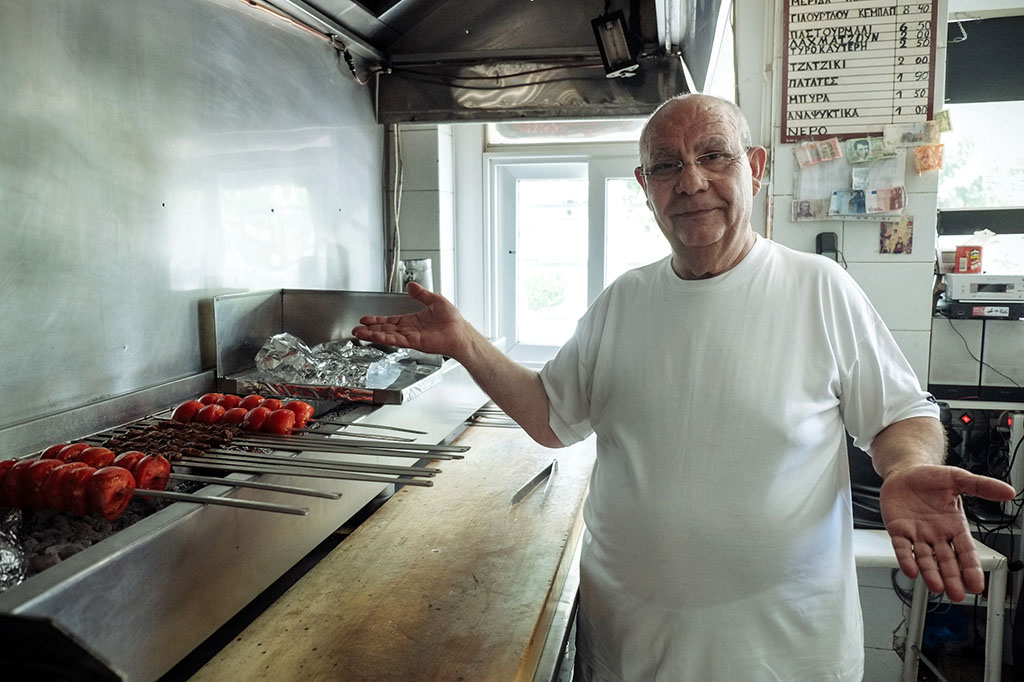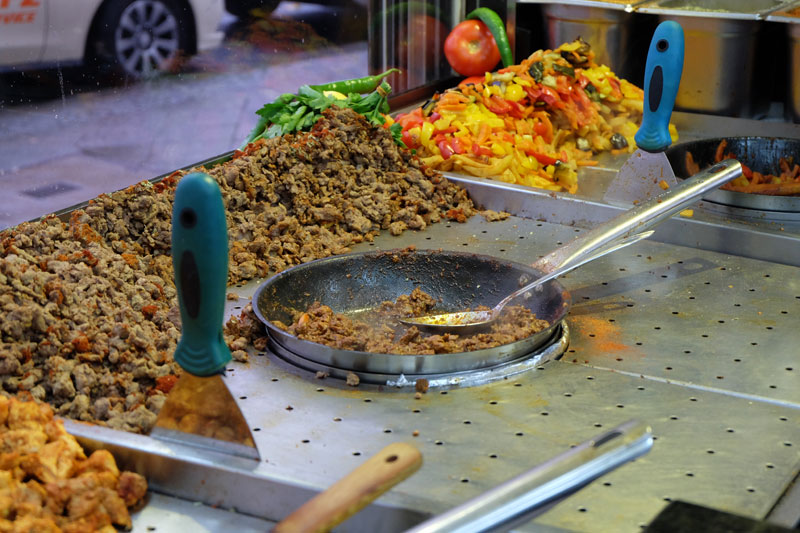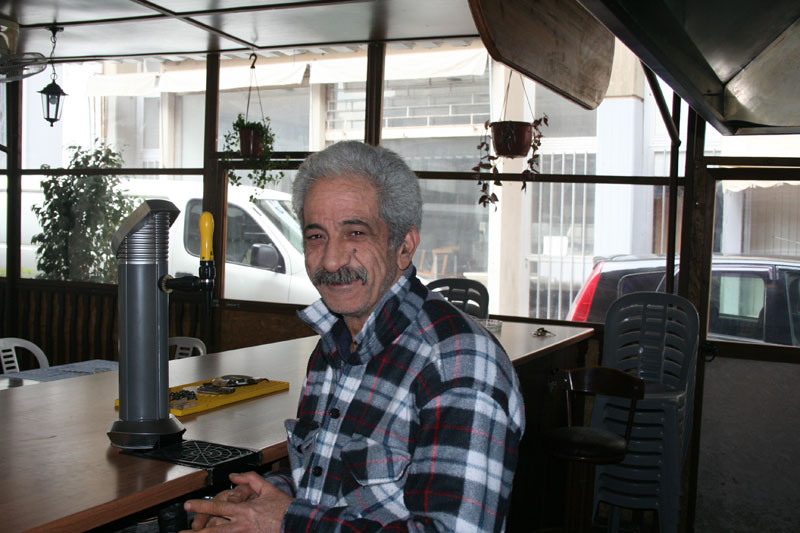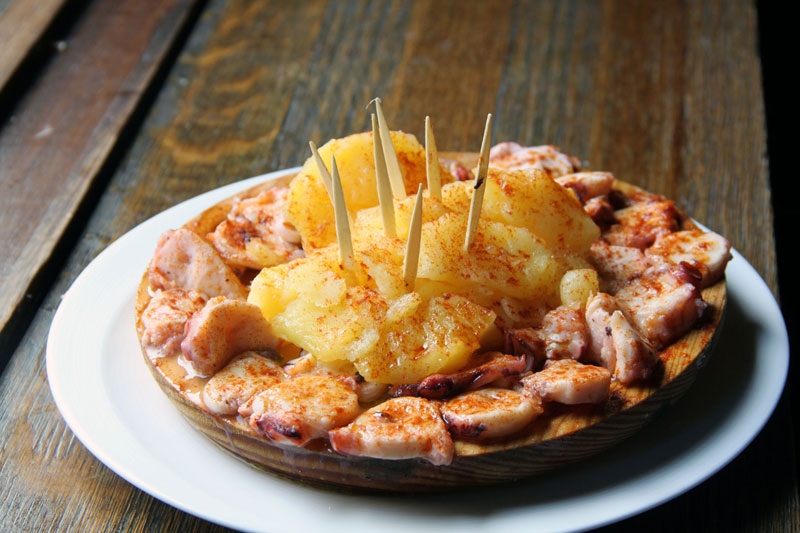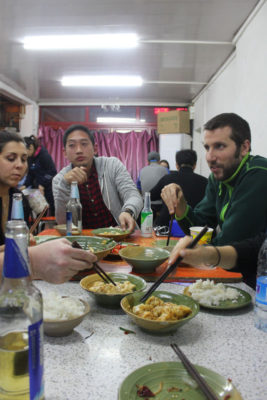We can't find the internet
Attempting to reconnect
Something went wrong!
Hang in there while we get back on track
Search results for
Shanghai
Gathering Clouds: Yunnan Mountain High
When “A Bite of China” came out in 2012, it took China – and the rest of the foodie world – by storm. The beautifully shot documentary showed Chinese culinary artisans around the country, watching them pull whole lotus roots from the mud in Zhejiang and make steamed buns from millet in Shanxi. Yunnan cuisine in particular emerged a star, as the program showcased what makes that region’s diet unique in China: its rich landscape and the artisans who produce goat cheese, cure ham and forage for wild mushrooms. Gathering Clouds (Yunnan means “south of the clouds”) is owned by a young, Yunnan-born crew, some of whom cut their teeth in the Shanghai dining scene at Lost Heaven, the most famous and foreigner friendly of the Yunnan restaurants in town.
Read moreRio
Beans & Beats: Pre-Gaming Carnival 2017
In Rio, there’s a saying, “And once again, suddenly it’s Carnival.” It’s a joke, of course – as if Carnival didn’t occupy cariocas’ minds a significant part of the year. But the truth is that, in a way, this is precisely what’s going on right now in the “Wonderful City.” Official Carnival events begin in two weeks, but the samba shows, parties, feasts and merriment are everywhere. Suddenly, it’s already Carnival. And this early Carnival mood expresses itself better every year at the samba schools’ rehearsals for the official parades, which are scheduled to begin on February 24. From next Thursday until then, at least 15 parties will take place at the most important samba schools’ headquarters, as well as in the Sambadrome – Rio’s main parade zone – itself.
Read moreIstanbul
Lipa: Meze On the Edge of Town
Convincing someone to accompany you to Istanbul’s Pendik district is no small feat. The Asian-side suburb is located in the far eastern reaches of the city, a trip of at least an hour and a half from the city center requiring no less than three metros and a cab. We've been met with moans and groans upon mentioning the name, as the district is synonymous to many with the wildfire-like urban sprawl that has engulfed Istanbul over the years. Those up for the journey, however, are rewarded handsomely at Lipa, a meyhane serving Bosnian specialties. The neighborhood of Sapan Bağları is home to a large population of natives from Sandzak, a predominantly Bosnian Muslim region now split across modern-day Serbia and Montenegro.
Read moreBarcelona
CB on the Road: Les Garrigues' Olive Oil Boom
In the southwestern part of Catalonia, in the province of Lleida, lies Les Garrigues, where the gray-green foliage of compact Arbequina olive trees stretches across some 20,000 hectares of the soft, dry landscape. This is where one of Spain’s best extra-virgin olive oils is produced. The olive tree has been cultivated in Catalonia since at least ancient Roman times, although it was probably first introduced by the Greeks in 600 BCE. Its cultivation developed alongside other typical crops that flourish in a dry climate – such as almonds, grains and grapes – until growing olives and producing olive oil became the main industry of Les Garrigues in the 19th century.
Read moreIstanbul
Lakerda: Istanbul's Salty, Fishy Soul
The fatty torik – the Turkish name for a large, mature Atlantic bonito, similar to the little tunny – courses the straits of the Bosphorus and the Dardanelles for just a short period each year in November and December. Yet the people of Istanbul eat it year-round by preserving the fish in a light brine, something it seems they have been doing for millennia – the Byzantines even minted coins with an image of the fish. Making lakerda is more than a means to preserve bonito for the rest of the year, however; it’s part of the city’s culinary instinct. Around 5 a.m. one recent morning in Yenikapı, yellow rubber boots were piled high in front of the one serene spot on the sprawling grounds of the Municipal Fish Auction.
Read morePorto
Francesinha: Porto's Heart-Stopping Sandwich
A gloppy, meaty, cheesy brick served in a pool of sauce and with a mountain of fries: please meet the francesinha, the culinary pride and joy of the city of Porto. Today, restaurant billboards proclaim in many languages that they serve the best version in the world, revealing the genuine power of this artery-clogging combination that, incredibly, was originally conceived as a snack. We have to say it though: eating a francesinha is worth every last calorie. This dense sandwich, which is impossible to eat just with your hands, is often considered the lusophone version of the croque monsieur.
Read moreAthens
Philippou: Bourgeois Comfort Food
Kolonaki, or “little column” in Greek, might just be Athens’ most iconic neighborhood, forever synonymous as it is in the minds of Athenians with the wealth and idiosyncrasies of its affluent residents. Occupying the area from Syntagma square up to Lycabettus hill, it’s full of swanky boutiques, cafes and restaurants. However, one of its most famous hidden gems is actually the unfussy Philippou, a small family-run eatery that sits on a tree-dotted street away from the hustle and bustle of the main square. Founded in 1923 by Kostas Philippou, it began as a humble taverna with earthen floors and big barrels filled with home-made wine.
Read moreTokyo
Jyaken Nou: Hiroshima House of Pancakes
What is it that’s so dizzyingly addictive about okonomiyaki? It might be the interactive DIY nature of building your own meal and serving it up from a Japanese teppan grill. Perhaps it’s the communal feeling of sitting around with a beer or two and cooking together. However, most likely is the fact that it’s so darn delicious and satisfying. It’s Japanese soul food that has somehow not quite reached the shores of many foreign countries. Okonomiyaki is a flavorful pancake chock full of whatever ingredients appeal, cooked on a Japanese grill (okono means “cook whatever you like” and yaki means grill). In all parts of Japan it's the secret second cousin to ramen in the family of fast food and cheap student eats.
Read moreLisbon
Drink Local: Lisbon's Craft Beer Revival
Portugal may be known for its abundance of wines, but beer also has a centuries-old history here, with production rooted in local traditions. It’s a story that has quietly been forgotten, but it seems like now is the right moment for a revival. Portugal’s beer landscape has since the 1940s been dominated by the Sagres-Super Bock duopoly, whose common lagers are nothing to write home about. Created out of a merger between previously competing associations, these two new brands (grouped under Central de Cervejas e Unicer) had a huge impact on Portuguese beer habits. The new industrial focus on a simple and standard product effectively wiped out hyper-local hops culture.
Read moreIstanbul
Al Ahdab: Groceries for the Homesick
(Editor's Note: In honor of the immigrants and refugees who have made their new home a better place for us all, this week we are running some of our favorite archived stories about those who have left a culinary mark on their adopted land.) On a recent sunny afternoon at the tiny Al Ahdab market, a wedge of light slashed through the front windows illuminating posters for condensed milk in Arabic script and one of an energy drink called Hell. The shop is easy to miss, tucked under the slope of Sarı Musa Sokak, which dips quickly from Millet Caddesi – the arterial avenue home to Istanbul’s Little Syria. By the front door was a rack of Cow Brand ghee, in large tin cans stacked like motor oil at a gas station.
Read moreIstanbul
A Slice of Georgian in a Pocket of Istanbul
We frequently venture to Istanbul's Aksaray district, where a small cluster of Georgian restaurants lie in close proximity to a bus station bringing people to and from the Caucasus. Giorgi serves up decadent, buttery khacaphuri and other Georgian classics, temporarily transporting one to Tbilisi.
Read moreAthens
Tomas Kebab: As the Kosmos Turns
(Editor's Note: In honor of the immigrants and refugees who have made their new home a better place for us all, this week we are running some of our favorite archived stories about those who have left a culinary mark on their adopted land.) "Despite the fact the Armenian quarter of Athens had been created out of the rubbish heap there was more charm and character to this little village than one usually finds in a modern city… In the midst of the most terrible poverty and suffering there nevertheless emanated a glow which was holy; the surprise of finding a cow or a sheep in the same room with a mother and a child gave way instantly to a feeling of reverence." This is Henry Miller’s description of Neos Kosmos in his 1941 travelogue, The Colossus of Maroussi. Known then as Dourgouti, Neos Kosmos (Greek for “New World”) was one of the shantytowns that had sprung up near the center of Athens housing the thousands of Anatolian Christians who had fled from Asia Minor after the Greco-Turkish War (1919-1922).
Read moreElsewhere
Toros: Tantuni (the Kreuzberg Remix)
(Editor's Note: In honor of the immigrants and refugees who have made their new home a better place for us all, this week we are running some of our favorite archived stories about those who have left a culinary mark on their adopted land.) In Berlin, there is no shortage of meatless options, and vegetarians can even rejoice in a seitan-based döner kebab that is given the proper spit roast. What did surprise us is that the ubiquity of vegetarian diets in the city has greatly impacted one version of a meat-centric Turkish street food classic.
Read moreMexico City
Tacos Árabes La Periquita: Pita Hut
(Editor's Note: In honor of the immigrants and refugees who have made their new home a better place for us all, this week we are running some of our favorite archived stories about those who have left a culinary mark on their adopted land.) Although we’re always hitting the pavement in search of the next good place to eat, sometimes places come to us. Such was the case with Tacos Árabes La Periquita, or “The Little Parrot,” an unassuming taquería in San Rafael that serves a relative rarity in Mexico City: “Arab tacos.”
Read moreWorldwide
Everyone Is Welcome Here
The ill anti-immigrant and -refugee wind blowing out of the White House in Washington, DC, does not represent the America we know, nor does it speak to our experience exploring the world’s culinary backstreets. The cities and countries where we work – the United States included – have always been havens for those looking for a better, safer place. All have come with their food, making their new home a truly better place for us all and becoming an indispensible part of its fabric in the process. When the government goes low, we go in search of more stories of immigrants and refugees who have left a culinary mark on their adopted land and whose tales have always been essential elements in what we do here at CB. In their honor, this week we are running some of our favorites of these kinds of stories from the CB archive (like that of Mr. Tomasian, pictured above, an Armenian kebab maker in Athens).
Read moreWorldwide
Street Carts of Desire: The Tamale Ladies of Roosevelt Avenue
(Editor's Note: The ill anti-immigrant and -refugee wind blowing out of the White House in Washington, DC, does not represent the America we know, nor does it speak to our experience exploring the world’s culinary backstreets. The cities and countries where we work – the United States included – have always been havens for those looking for a better, safer place. All have come with their food, making their new home a truly better place for us all and becoming an indispensible part of its fabric in the process. In their honor, this week we are running some of our favorite archived stories of immigrants and refugees who have left a culinary mark on their adopted land.) If you walk the length of Roosevelt Avenue from 69th Street to 111th Street in the early morning, you may encounter up to two dozen tamale ladies, usually at the major intersections that correspond to the 7 train’s stops.
Read moreMexico City
Tacos Manolo: Singular Sensation
Like many of Mexico’s best taquerías, Tacos Manolo greets its patrons from a block away with its alluring smell. But it isn’t the well-known odor of fired achiote on a swirling spit of al pastor or the equally recognizable heavy scent of bistek searing on a griddle. No, the aroma wafting down this particular block of Calle Luz Saviñon is a mystery to the uninitiated – a unique, unplaceable perfume that allures as much as it confuses. It is the smell of onions and unknown meats and mystery sauces bubbling together, fusing into something greater and more delicious than the sum of its parts. It is the smell of the eponymous Taco Manolo, a one-of-a-kind dish that has brought the restaurant fame and accolades.
Read moreTbilisi
Vino Underground: Wine Heaven
Ènek poured a rosy-colored splash of wine into our glasses, avidly explaining how this particular Aladasturi grape vine was meticulously cultivated in its native west Georgia. In a tasting ritual uncommon in Georgia, we swirled it, sniffed it and savored the flavor as it caressed our tongues. Here in the “cradle of wine,” the land where viticulture is believed to have originated 8,000 years ago, wine is customarily poured into a water glass and “tasted” in one long drag, until drained. But in this cozy cellar in the heart of Tbilisi’s historic Sololaki neighborhood, seven winemakers have come together to offer an alternative convention to winemaking and consumption. They call it Vino Underground, but we call it wine heaven.
Read moreElsewhere
Berlin Wall No2: Hole in the Border
Berlin Wall No2 is a rickety wood and plastic-sheeting structure on the pavement right on the Greek-Cypriot side of the “green line,” as the border that divides the Cypriot capital is known. It’s overlooked by guards and is a five-minute stroll from the more stylish eateries in the center of Nicosia’s Old Town. But this little hole-in-the wall serves the best sheftalia we’ve eaten in the city. You could argue about whether these wonderful little nuggets are a form of sausage – what the French would call crepinettes. Two cuts of pork – backfat and loin – are minced, mixed with onions, herbs and seasonings, then encased in caul fat – the membrane that surrounds a pig’s stomach – and grilled over charcoal.
Read moreRio
Bar Roda Viva: Pig Out
Once upon a time, three brothers decided to immigrate. They left their hometown, an extremely poor city called Canindé, in the northeastern state of Ceará, went to Rio de Janeiro and started working in construction. They built a lot of brick walls, ceilings and roofs. Then, after two years of hard work, they decided to open a bar where they would sell roast chicken, northeastern food and grilled pork ribs. That bar, officially called Roda Viva, became known as Três Porquinhos (Three Little Pigs) when a customer connected the image of the three brothers working together with the classic children’s tale.
Read moreShanghai
Chinese Wine: The Grape Leap Forward
Don’t tell it to French winemakers, but in 2015, the Chinese wine industry hit a major milestone by narrowly surpassing France in land dedicated to vineyards. With 7,990 square kilometers of grape-growing land concentrated mostly in China’s north-central and northwestern regions, the country now ranks second only to Spain and holds almost 11 percent of the world’s vineyards by land area. Most experts estimate that the vast majority of these vineyards grow grapes for the table, not wine, but the statistic follows the trend of wine’s growing popularity in the Middle Kingdom. And China is now among the top 10 wine-producing countries in the world.
Read moreBarcelona
Best on Bread: Barcelona's Top Sandwiches
Between two simple slices of bread exists a mind-boggling array of possibilities – something not lost on Spaniards, who have turned sandwich making into something of an art form. In Spain, sandwiches go by different names depending on the kind of bread used and local custom. The type that’s generally called a bocadillo in Spanish and entrepà in Catalan traditionally comes on pan de barra, itself a broad category of bread, with varying dimensions, qualities and more specific names, including baguette, maybe chapata (ciabatta), depending on how round the bakery makes it, pistola (pistol) in Madrid and flautas (flutes) in Barcelona if it’s short and very thin.
Read moreLisbon
Santa Apolónia: Station to Station
Cities experiencing rapid urban transformation often find themselves suspended between past and future, with those respective cultures in close juxtaposition. The Santa Apolonia train station, a simple neoclassical building from the 19th century that once served as Lisbon’s central rail hub, is a good example of this; a visit to its north and south sides reveal different routines, atmospheres and of course, flavors. On the waterfront, a few former dock warehouses are the home of gourmet palates. Cais da Pedra, the project of the famous chef Henrique Sá Pessoa, is a modern restaurant decorated in stone, iron and mirrors.
Read moreTbilisi
The Treasures of Tbilisi's Dezerter's Bazaar
We can't think of a better way to kick off the new year than with a jolting shot of chacha chased with a sharp wedge of sheep's cheese at Tbilisi's Dezerter's Bazaar. This market is the focal point of our culinary walk in the city and is jam-packed with treasures.
Read moreIstanbul
Çiğköftecisi Orhan Usta: Heat Merchant
Visitors to Istanbul's iconic Spice Bazaar encounter a place packed wall-to-wall with overzealous shopkeepers selling everything from saffron to sumac assembled in rows of majestic pyramids at slightly inflated prices. But for our money, the only spices worth a damn are found just outside in a humbler setting. Crammed behind a tiny kiosk perched in front of a fast-food restaurant that flanks one of the bazaar's entrances is the endearing Orhan usta. The loveable 65-year-old is a veritable master of çig köfte and a connoisseur of the spicy red pepper flakes cultivated in his hometown of Gaziantep, the southeastern city considered by many to be Turkey's culinary capital.
Read moreElsewhere
O Pazo de Lugo: Galician Formula
Galician restaurants have had a strong presence in Madrid since the 1950s, when the northwestern region’s economic crisis triggered a solid exodus of people towards industrial Spanish cities. This migratory wave, alongside the fact that Galician gastronomy was (and still is) considered one of the best in the country, meant a boom of new restaurants in the capital. It was in the 1970s when brothers Francisco and Marcial Javier moved to Madrid from Lugo, an interior city of Galicia known for its Roman walls, rainy weather and rich food.
Read moreTokyo
Hasegawa Saketen: For Goodness Sake
Sake is a very deeply ingrained part of Japanese culture and its function is everything from ceremonial to social. It might be surprising then to know that there are remarkably few establishments in Tokyo dedicated to simple sake tasting. This is perhaps because the roots of public sake drinking stretch back to the 1800s, when sake was bought directly from a seller and often consumed on the premises with bits of food. Back then, people stood next to sake kegs and enjoyed the brew, eventually turning crates and barrels on their sides and sitting to enjoy their drinks. Food was soon added and the izakaya was born (a sakaya is a place to purchase sake, and the “i-“ prefix means “to stay.”).
Read moreIstanbul
Doyuran Lokantası and Boris'in Yeri: Working-Class Heroes
We usually steer clear of the touristy Old City district of Kumkapı, where you are more likely to be accosted by an aggressive maitre d’ trying to corral you into his overpriced fish restaurant than to find something simple, tasty and reasonably priced to eat. Sadly, in order to beat the competition next door, most of Kumkapı’s famed fish restaurants seem to have invested more in aggressive customer corralling tactics than in kitchen talent. However, tucked into the neighborhood’s backstreets, we’ve found a few hidden dining gems that locals in the know frequent. When in the area, we skip Kumkapı’s fish restaurant strip and make a beeline for Doyuran Lokantası, a serious little eating sanctuary on a nearby side street.
Read moreMexico City
La Miniatura: Small Cakes, Big Business
Julian Ramirez started out at the age of 14 as a shop boy at a busy bakery in Colonia Guerrero in 1959, then a bustling blue-collar neighborhood, easily connected to downtown by streetcar. Back then, at La Antigua del Guerrero, he learned the business: wiping windows, sweeping up and eventually making deliveries on his bike. One nibble at a time, he picked up the art of cake- and bread-making from the shop’s master bakers. Those trade secrets would serve him over the next 63 years and beyond as they pass on to his kids and theirs. Many of Mexico’s classic bakeries like the Guerrero operation fell one by one with the introduction of mass-produced bread, tearing at a staple of communities across the capital.
Read moreRio
Bar do David: The Little Buteco that Could
What's better than a day at the beach? How about a day at the beach followed by fresh seafood and a cold beer in a vibrant neighborhood with views to boot? Bar do David sits on a busy corner in Rio's Chapéu Mangueira, a favela that overlooks the beaches of Leme and Copacabana. On a recent Sunday afternoon, the bar's two floors and outdoor area were packed with locals and tourists noshing on plates ranging from feijoada de mariscos, a white-bean and seafood take on the classic Brazilian bean stew, to the Estrela do David (Star of David), pineapple-mint pork rib tacos.
Read moreIstanbul
A Much-Needed Istanbul Blizzard
A heavy snowstorm left a thick layer of powder in Istanbul, resulting in cancelled classes for several days, and the arrival of countless snowmen. Snowball fights broke out left and right, neighborhood kids used whatever they could to slide down icy hills. Demeanors softened, moods improved. After a tragic beginning in 2017, the city received a much-needed blessing from the sky.
Read moreAthens
Seychelles: Post-Industrial Cooking
The neighborhood of Metaxourgio in central Athens gets its name from the historic Athanasios Douroutis silk factory (metaxi means “silk”), which closed down in 1875. The former factory, which now houses the Municipal Art Gallery, was designed in 1833 by the Danish architect Hans Christian Hansen and is among the city's most important surviving neoclassical structures. The building was originally intended to be a shopping center, but because the area became an industrial zone, it inevitably attracted mostly working-class residents who were employed in the nearby factories, smaller industries or workshops.
Read moreTbilisi
Maspindzelo: Hangover Helper
We spent our first few years in Georgia in a whirlwind of overindulgence, hostages to the unforgiving hospitality of friends and acquaintances. Try as they might to convince us that their wine and chacha were so “clean” we would not get hangovers, there were plenty of mornings when the insides of our skulls felt like 60-grain sandpaper and our tongues like welcome mats for packs of wet street mongrels. We would hobble out of bed and stumble to the fridge and, if lucky, find two of Georgia’s most recognized hangover remedies: Borjomi mineral water and matzoni, Georgian yogurt.
Read moreLisbon
Varinas: Lisbon's Vanished Roving Fishmongers
Varinas may no longer be prowling the streets of Lisbon, yet they remain iconic characters of the city. Until the 1980s, one would regularly hear these women loudly advertising the fresh fish they sold out of baskets they carried on their heads as they walked the hilly streets around the Lisbon. “In the 18th and 19th centuries, there was what we call the ‘aveirense invasion.’ They were coming mostly from the Aveiro region in northern Portugal, particularly from Ovar,” explains Appio Sottomayor, a journalist, author and a renowned expert in Lisbon history. (This is why they were known as ovarinas and eventually, once the “o” was dropped, varinas.)
Read moreElsewhere
Zhang Mama: Spicy Lady
When a menu is written only in Chinese characters, it presents a language barrier for foreigners. When a restaurant offers a Mandarin-only menu and requires diners to handwrite their order in characters, that molehill becomes an actual mountain. But Zhang Mama doesn’t care – diners have been queuing up for upwards of an hour outside the dingy hutong restaurant for a bite of its Sichuan cuisine since it opened in 2009. Why? It’s equal parts delicious and cheap. Demand got so high for this hole-in-the-wall shop that they opened two more shops, one just down the street from the Dongcheng district original and another in Chaoyang district. But it’s still not easy to get a seat during peak mealtimes.
Read moreMexico City
Tacos Beto: Deep Dive
Tacos Beto is not a pretty place. Stacks of soda bottles, enough for weeks to come, serve as a wall that shields customers from the wind blowing down Avenida Dr. José María Vertiz. The plastic tables and plastic stools that surround the bottles seem older than the invention of plastic. A long, dusty awning hanging above the sidewalk seating advertises a brand of soda that Tacos Beto no longer carries, maybe never carried. The only visible beauty encountered at the restaurant sits on the arched wall above the steel fryer, or comal bola – orange and blue paint spell out the words “Tacos Beto – los de cochinada” (“Tacos Beto – the garbage ones”).
Read moreBarcelona
Building Blocks: Olive Oil, Spain's Liquid Gold
Spain, Italy, Greece, Turkey, Portugal, Morocco, Tunisia – one thing that unites this swathe of the Mediterranean is olive oil, whose use in the Fertile Crescent can be traced back to 6000 B.C.E. Olives arrived in the southern part of the Iberian Peninsula around 9th century B.C.E. with the Phoenicians. Ancient Rome saw huge quantities of olive oil from Hispania Baetica (currently Andalucía) being transported throughout the Roman Empire in millions of amphorae (made in Baetica). Spain leads production of olive oil to this day, with 45 percent of the global total. The majority (65 percent) of Spanish olive oil production is sold to Italy, where this oil is mixed with others (normally of the same quality, but not always) and sold under an Italian label.
Read moreIstanbul
Asır: Meze Master
On our way to dinner one Friday evening, we hopped in a cab headed for Tarlabaşı, a rather infamous neighborhood in the dead center of Istanbul in which many people still refuse to set foot. The area was a longtime hotbed of Greek and Armenian artisans and tradesmen, once the backbone of Ottoman-era Istanbul’s commercial life, who erected rows of gorgeous European-style apartment buildings beginning in the 19th century. Many stand proudly today, while dozens of others are fenced off and awaiting renovation as part of an invasive gentrification project that seeks to remodel the now decrepit, impoverished Tarlabaşı. By the end of 1970s, Tarlabaşı's Greeks and Armenians had packed up and left the neighborhood and the country, following difficult decades of anti-minority policies and attacks. In their place came a motley crew of other disenfranchised people: Kurds fleeing conflict in the southeast of the country, Roma living on the fringes of society, transgender sex workers, economic migrants and political refugees.
Read moreAthens
Ama Lachi stis Nefelis: School Lunch (and Dinner)
Through the gate on Kallidromiou and down the steps, the enchanting stone-paved courtyard at last reveals itself, a hidden oasis of fragrant lemon trees, geraniums, bougainvillea and jasmine in this densely built neighborhood. A charming mural of children in class is painted on one side of the yard, right next to the water fountains that thirsty students used to run to during their break. Inside, walls are decorated with old black-and-white photos from the school’s archives. A modern mezedopoleio housed in a historical neoclassical building, Ama Lachi stis Nefelis (If by Chance at Nefeli’s) holds the unusual distinction of being the former public primary school of Exarchia.
Read morePorto
Matosinhos: Song of the Sea
Matosinhos, a small city just north of Porto, is used to change. It has an industrial air to it, due to its 19th-century harbor, and its past prosperity was connected to the fish-canning sector, which peaked during World War II and declined from the beginning of the 70s. The numerous abandoned warehouses attracted nightlife during the 1990s, with clubs finding a fertile zone for noise. The completion of the long-delayed tidal pool, built by Portugal's starchitect, Alvaro Siza (who was born in the city), put it firmly on the map again after the project was delayed for decades. In January, the launch of the new, spiralling cruise ship terminal added to the contemporary design-y feel that has been developing on its otherwise rugged coastline.
Read more











